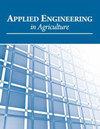Risk Assessment Methods for Autonomous Agricultural Machines: A Review of Current Practices and Future Needs
IF 0.9
4区 农林科学
Q4 AGRICULTURAL ENGINEERING
引用次数: 2
Abstract
Highlights Risk assessment for highly automated and autonomous agricultural machines must consider risks beyond operator risk. Engineering standards are a starting point for autonomous equipment risk assessment but are not yet adequate. Engineers designing highly automated equipment now assess risk holistically but need more tools and support. Education in accredited engineering programs and professional development should include risk assessment. Abstract. Technology continues to advance in agricultural machines and includes the development of highly automated, robotic, autonomous, and other types of machines used in fields, farmsteads, buildings, and other farm production locations. New engineering design and safety-related standards have been developed in the past half-decade, but safety remains a concern of key stakeholders and is a barrier that could influence widespread adoption. A survey of practicing engineers and researchers involved with highly automated and autonomous agricultural machine design will be presented that shows the methods for risk assessment and control currently in use including different frameworks for hazard and failure identification, prediction, and quantification. The use of engineering design standards (ASABE, ISO, and others) among practitioners is discussed including some important needs that go beyond obstacle detection and injury prevention for operators. These include safety and risk issues connected to animals, property, civic infrastructure, downtime, cyber, and environmental risk. Commonly used risk assessment methods such as the related failure modes and effects analysis (FMEA) or hazard analysis and risk assessment (HARA) are a useful starting point but are based on historical data and experience that can be used to estimate the probability and severity levels of undesirable failures or incidents such as injuries. These data do not yet exist as compared to risk assessment data that can be used to assess incident occurrence probability, failure, detectability, or controllability in more traditional machines. Suggestions are presented for further development of standards and practice recommendations including software needs and operational data that might be used by autonomous machines that is informed by what we do know about past farm incidents that could include accidents, injuries, and other unexpected failures. Keywords: Automation, Autonomous agricultural machinery, Engineering design standards, Farm equipment, Risk assessment, Robotics, Safety.自主农业机械风险评估方法:当前实践与未来需求综述
高度自动化和自主农业机械的风险评估必须考虑操作员风险之外的风险。工程标准是自主设备风险评估的起点,但目前还不充分。设计高度自动化设备的工程师现在可以全面评估风险,但需要更多的工具和支持。经过认证的工程项目和专业发展的教育应包括风险评估。摘要农业机械的技术不断进步,包括在田地、农场、建筑物和其他农业生产场所使用的高度自动化、机器人、自主和其他类型的机器的发展。在过去的五年里,新的工程设计和安全相关标准得到了发展,但安全仍然是关键利益相关者关注的问题,也是可能影响其广泛采用的障碍。一项对从事高度自动化和自主农业机械设计的实践工程师和研究人员的调查将展示目前使用的风险评估和控制方法,包括危害和故障识别、预测和量化的不同框架。讨论了从业人员对工程设计标准(ASABE、ISO等)的使用,包括对操作人员障碍物检测和伤害预防之外的一些重要需求。其中包括与动物、财产、市政基础设施、停机时间、网络和环境风险相关的安全和风险问题。常用的风险评估方法,如相关失效模式和影响分析(FMEA)或危害分析和风险评估(HARA)是一个有用的起点,但它们是基于历史数据和经验,可用于估计不希望发生的故障或事故(如伤害)的概率和严重程度。与风险评估数据相比,这些数据尚不存在,风险评估数据可用于评估传统机器中的事件发生概率、故障、可检测性或可控性。提出了进一步制定标准和实践建议的建议,包括软件需求和自动机器可能使用的操作数据,这些数据来自我们对过去农场事件的了解,这些事件可能包括事故、伤害和其他意外故障。关键词:自动化,自主农业机械,工程设计标准,农用设备,风险评估,机器人,安全
本文章由计算机程序翻译,如有差异,请以英文原文为准。
求助全文
约1分钟内获得全文
求助全文
来源期刊

Applied Engineering in Agriculture
农林科学-农业工程
CiteScore
1.80
自引率
11.10%
发文量
69
审稿时长
6 months
期刊介绍:
This peer-reviewed journal publishes applications of engineering and technology research that address agricultural, food, and biological systems problems. Submissions must include results of practical experiences, tests, or trials presented in a manner and style that will allow easy adaptation by others; results of reviews or studies of installations or applications with substantially new or significant information not readily available in other refereed publications; or a description of successful methods of techniques of education, outreach, or technology transfer.
 求助内容:
求助内容: 应助结果提醒方式:
应助结果提醒方式:


